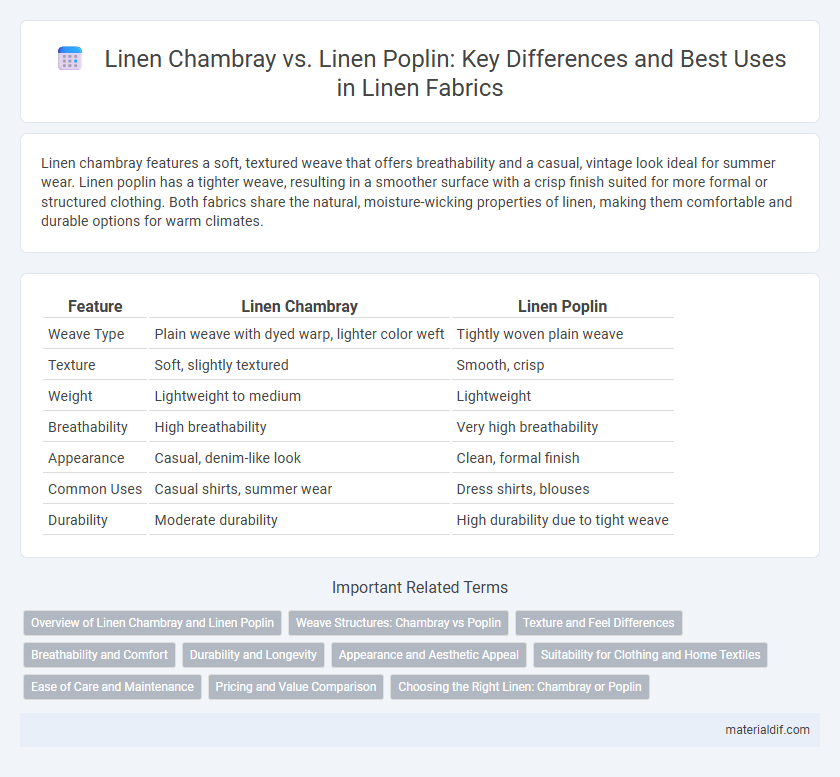Linen chambray features a soft, textured weave that offers breathability and a casual, vintage look ideal for summer wear. Linen poplin has a tighter weave, resulting in a smoother surface with a crisp finish suited for more formal or structured clothing. Both fabrics share the natural, moisture-wicking properties of linen, making them comfortable and durable options for warm climates.
Table of Comparison
| Feature | Linen Chambray | Linen Poplin |
|---|---|---|
| Weave Type | Plain weave with dyed warp, lighter color weft | Tightly woven plain weave |
| Texture | Soft, slightly textured | Smooth, crisp |
| Weight | Lightweight to medium | Lightweight |
| Breathability | High breathability | Very high breathability |
| Appearance | Casual, denim-like look | Clean, formal finish |
| Common Uses | Casual shirts, summer wear | Dress shirts, blouses |
| Durability | Moderate durability | High durability due to tight weave |
Overview of Linen Chambray and Linen Poplin
Linen Chambray features a lightweight, plain weave with a soft drape and subtle texture, often showcasing a blend of colored warp and white weft for a heathered appearance. Linen Poplin is characterized by a tightly woven, smooth, and crisp finish, providing durability and a polished look ideal for formal shirts and summer garments. Both fabrics leverage linen's breathability and moisture-wicking properties but differ in weave structure, texture, and typical applications.
Weave Structures: Chambray vs Poplin
Linen chambray features a plain weave with colored warp and white weft threads, creating a subtle, textured appearance ideal for casual wear. Linen poplin uses a tighter, basket-weave structure with equally spun threads, resulting in a smooth, crisp fabric often preferred for formal shirts. The distinct weave structures affect breathability, drape, and the overall aesthetic of the garments made from each linen type.
Texture and Feel Differences
Linen chambray features a soft, slightly textured weave with a subtle color variation, creating a casual, breathable fabric ideal for relaxed wear. Linen poplin offers a smoother, tighter weave with a crisp surface, providing a polished, lightweight feel suited for formal garments. The tactile difference lies in chambray's gentle roughness versus poplin's sleek smoothness, impacting drape and comfort.
Breathability and Comfort
Linen chambray features a looser weave that enhances breathability, making it ideal for hot and humid climates. Linen poplin has a tighter weave, offering a smoother texture with slightly less airflow but greater durability and wrinkle resistance. Both fabrics provide excellent comfort due to linen's natural moisture-wicking properties, but chambray excels in keeping the wearer cooler.
Durability and Longevity
Linen chambray offers enhanced durability due to its tighter weave and thicker yarns, making it more resistant to wear and tear compared to linen poplin. Linen poplin, characterized by a finer and smoother texture, tends to be lighter but less resistant to abrasion, which can affect its longevity over time. For applications requiring long-lasting fabric, linen chambray is the preferred choice because of its superior strength and resilience.
Appearance and Aesthetic Appeal
Linen chambray features a subtle two-tone weave that creates a soft, textured appearance with a slightly heathered effect, giving garments a casual yet refined aesthetic. In contrast, linen poplin offers a smooth, crisp surface with a tight, plain weave that produces a sleek and polished look ideal for formal wear. The distinct weave patterns influence their visual texture, with chambray exhibiting more depth and poplin showcasing a clean, minimalist finish.
Suitability for Clothing and Home Textiles
Linen Chambray offers a soft texture and subtle color variation, making it ideal for casual clothing and relaxed home textiles like curtains and pillow covers. Linen Poplin features a smooth, crisp finish with a dense weave, providing durability and a polished look suitable for tailored garments and high-quality bed linens. Both fabrics leverage linen's breathable, moisture-wicking properties, enhancing comfort in apparel and domestic uses.
Ease of Care and Maintenance
Linen Chambray offers a slightly textured surface that hides wrinkles better than Linen Poplin, making it easier to maintain a polished look with minimal ironing. Linen Poplin, being finer and smoother, requires more delicate washing and frequent pressing to retain its crisp appearance. Both fabrics benefit from gentle machine washing and line drying, but Chambray's durability reduces the need for intensive care routines.
Pricing and Value Comparison
Linen Chambray typically commands a higher price than Linen Poplin due to its unique weave that offers a softer texture and greater breathability, making it ideal for premium casual wear. Linen Poplin, known for its crispness and durability, provides excellent value for structured garments at a more affordable price point. Consumers seeking luxurious comfort often invest in Linen Chambray, while those prioritizing budget and versatility frequently opt for Linen Poplin.
Choosing the Right Linen: Chambray or Poplin
Linen chambray offers a soft texture with a subtle, heathered appearance ideal for casual wear and breathable summer clothing, while linen poplin provides a smooth, crisp finish perfect for structured garments and formal attire. Chambray's lightweight, airy weave enhances comfort in warm climates, whereas poplin's dense, durable fabric resists wrinkles and holds shape well. Selecting between linen chambray and poplin depends on desired garment style, texture preference, and intended use, balancing breathability with fabric strength.
Linen Chambray vs Linen Poplin Infographic

 materialdif.com
materialdif.com